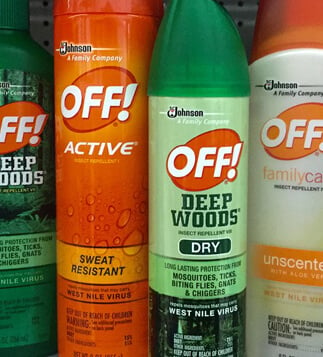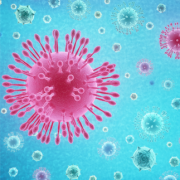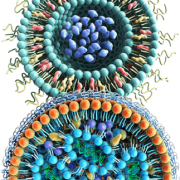Small Pollution Study Intrigues Celiac Disease Experts
 “A combination of pollutants, plus genes, plus exposure to gluten may cause celiac disease,” said Jeremiah Levine, MD
“A combination of pollutants, plus genes, plus exposure to gluten may cause celiac disease,” said Jeremiah Levine, MD
- Kate O’Rourke, Gastroenterology & Endoscopy News 1
While previous research has demonstrated that the origins of celiac disease are largely genetic, a new study reveals that an underlying cause of the disease also may be environmental. The study, submitted to the 2020 Digestive Disease Week (abstract 1120), found that levels of toxic chemicals found in pesticides, nonstick cookware and fire retardants are increased in young people with celiac.
“It is not that our study shows that pollutants cause celiac disease. We think it is a combination of pollutants, plus genes, plus exposure to gluten that causes the disease,” said Jeremiah Levine, MD, a pediatric gastroenterologist at NYU Langone Health, in New York City, and the senior investigator on the research project.
“Our study establishes the first measurable tie-in between environmental exposure to toxic chemicals and celiac disease.”
Dr. Levine said he launched the study because of the unexplained increase in the incidence of celiac disease, which affects roughly one in 100 adults worldwide. He has had a long-standing interest in whether environmental issues could be contributing to the increased incidence of gastrointestinal diseases.
While the HLA-DQ2 and HLA-DQ8 genotypes play a clear and important role in the pathology of celiac disease, evidence from mouse models suggests that genetic predisposition and exposure to gluten are not the only factors contributing to the condition, Dr. Levine said.
To conduct the study, Dr. Levine’s group prospectively evaluated all children who presented at NYU Langone Hassenfeld Children’s Hospital with complaints that would raise concerns about the possibility of celiac disease. The researchers then followed the children to determine who had celiac disease and who did not and evaluated their exposure to persistent organic pollutants (POPs).
These halogenated, synthetic organic compounds are used in a variety of manufacturing and industrial processes, and are known endocrine disruptors with a plausible link to celiac disease, given the interplay between the endocrine and immune systems, according to the researchers.
The study cohort included 30 children and young adults, aged 3 to 21 years, who were newly diagnosed with celiac disease, and 60 other young people without the disease of similar age, sex and race.
After controlling for sex, race, age, BMI and genetic susceptibility, researchers found:
- Patients with higher concentrations of serum p,p’-dichlorodiphenyldichloroethylene (DDE) had double the risk for celiac disease (95% CI, 1.08-3.84).
- After stratifying by sex, the researchers found higher odds of celiac disease in females with serum concentrations of DDE (odds ratio [OR], 13; 95% CI, 1.54-110), perfluorooctanesulfonic acid (OR, 12.8; 95% CI, 1.17-141), and perfluorooctanoic acid (OR, 20.6; 95% CI, 1.13-375) and in males with serum BDE153, a polybrominated diphenyl ether (PBDE) congener (OR, 2.28; 95% CI, 1.01-5.18).
DDE is the main metabolite of dichlorodiphenyltrichloroethane, which was predominately used as an insecticide until U.S. regulators banned the substance in 1972. Perfluoroalkyl substances including perfluorooctanesulfonic acid and perfluorooctanoic acid are commonly used as surfactants and polymers for consumer products and building materials. PBDEs are ingredients in flame retardants in upholstered furniture, mattresses and electronic products.
Although many of these substances have been or are being phased out of use, they are resistant to degradation and can accumulate in animal and human tissue.
Dr. Levine said the new findings may help to explain why some children with genetic susceptibility develop celiac disease while others remain disease-free. Dr. Levine said the POPs his group analyzed may act by altering tight junctions in the gut, allowing for gliadin—a key protein in gluten—to more easily cross the small intestinal epithelium. Alternatively, POPs may act in an endocrine-disrupting manner by enhancing the immune response after gliadin has crossed the intestinal barrier, he said.
- “This study suggests that there may be a role in environmental exposure predisposing patients who are otherwise predisposed to develop celiac disease because of genetics to developing celiac disease, potentially through the effect on the gut barrier or on immune disruption,” Dr. Levine said.
- “One should look further with regard to the association between exposure to organic pollutants and the development of celiac disease, and in addition, potentially look for other autoimmune diseases that similarly may have underlying environmental triggers.”
- “This study is not proof of causality, and that is an important point,” said Joseph Murray, MD, a professor of medicine and celiac expert at Mayo Clinic in Rochester, Minn., who was not involved in the research. “This study raises the possibility that maybe these [POPs] are not safe, at least in this example of an autoimmune condition. There is no question that a lot more work will be needed to confirm the association and then to identify or determine if there is a causal relationship between them.”
- Dr. Murray provided an alternative explanation for the findings. “There is the possibility of what is called reverse causality, that having celiac disease makes your body take up more of these organic substances,” he said.













